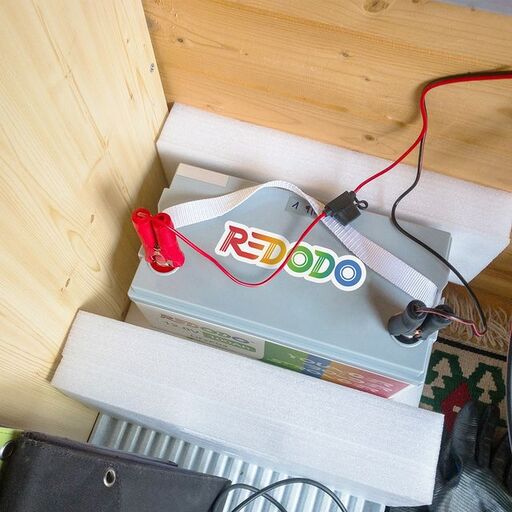LiFePO4 Lithium Batteries in Series VS Parallel Connection
Connecting lithium-ion batteries in parallel or series is more complex than merely linking circuits in series or parallel. Ensuring the safety of both the batteries and the person handling them requires careful consideration of several crucial factors. Before addressing the necessary precautions, it's essential to understand the basics of parallel and series circuits, including their definitions and unique characteristics.
Table of Content
Series Connection of LiFePO4 Batteries
The Definition of Series Connection
Series connection of LiFePO4 batteries involves linking multiple cells in a sequence to boost the total voltage output. In this setup, the positive terminal of one cell connects to the negative terminal of the next cell, continuing this pattern until the desired voltage is reached.

While the overall capacity of the battery pack remains identical to that of a single cell, the voltage output increases. This type of connection is typically employed in applications requiring high voltage, such as electric vehicles, solar power systems, and backup power supplies for buildings.
The Advantages of Series Connection
Connecting LiFePO4 batteries in series offers several advantages, including:
- Higher Voltage Output: Connecting multiple cells in series increases the total voltage output of the battery pack, making it suitable for applications requiring higher voltage. For instance, connecting four 12.8V batteries in series results in a total voltage of 51.2V.
- More Efficient Energy Storage: In a series-connected battery pack, each cell shares the load equally, ensuring uniform charging and discharging rates. This leads to more efficient overall energy storage.
Series connection is ideal for applications that require high voltage, such as electric vehicles and solar power systems. It enables efficient energy storage and ensures even distribution of charge and discharge across the battery pack.
The Disadvantages of Series Connection
Connecting LiFePO4 batteries in series also has some drawbacks, including:
Risk of Overcharging: If the cells in a series-connected battery pack have different capacities or ages, they may discharge at different rates, leading to voltage imbalances. This can result in overcharging some cells, which is dangerous and can shorten the battery pack's lifespan.
Decreased Capacity: In a series-connected battery pack, the overall capacity is limited to that of a single cell. Thus, connecting cells in series does not increase the total capacity of the battery pack.
To mitigate these issues, it's crucial to ensure that all cells in the series-connected pack have similar capacities and ages. Additionally, proper charging and continuous monitoring of the pack's voltage are essential to prevent overcharging and to ensure efficient operation of the battery pack.
Read More: How To Charge LiFePO4 Battery Safely?
Parallel Connection of LiFePO4 Batteries
The Definition of Parallel Connection
Parallel connection of LiFePO4 batteries involves connecting multiple cells by linking their positive terminals together and their negative terminals together to increase the overall capacity of the battery pack.

In this setup, each cell shares the load equally, resulting in a higher current output and increased overall capacity. However, the voltage output of the battery pack remains the same as that of a single cell. Parallel connections are commonly used in applications requiring high capacity, such as backup power supplies for buildings, off-grid solar power systems, and electric vehicles.
The Advantages of Parallel Connection
Parallel connection of LiFePO4 batteries offers several distinct advantages:
- Increased Capacity: By connecting multiple cells in parallel, the total capacity of the battery pack is significantly enhanced, making it well-suited for applications demanding high capacity. For instance, connecting four 12.8V 100Ah batteries in parallel maintains the voltage at 12.8V while increasing the capacity to 400Ah.
- Reduced Risk of Overcharging: In a parallel-connected battery pack, each cell charges and discharges independently. This configuration mitigates the risk of overcharging or undercharging individual cells, thereby enhancing the safety and prolonging the lifespan of the entire battery pack.
Parallel connections are optimal for applications requiring substantial capacity, such as backup power supplies for buildings and off-grid solar power systems. This configuration facilitates efficient energy storage and ensures an even distribution of charge and discharge across the battery pack.
The Disadvantages of Parallel Connection
Parallel connection of LiFePO4 batteries also has some drawbacks, including:
- Lower Voltage Output: In a parallel-connected battery pack, the overall voltage output remains the same as that of a single cell. Thus, connecting cells in parallel does not increase the pack's overall voltage.
- Less Efficient Energy Storage: Since each cell in a parallel-connected battery pack charges and discharges independently, variations in the state of charge of each cell can occur, leading to less efficient energy storage.
To mitigate these issues, it's crucial to ensure that all cells in the parallel-connected pack have similar capacities and ages. Additionally, proper monitoring of the pack's voltage and state of charge is essential to prevent undercharging or overcharging and to ensure the efficient operation of the battery pack.
Comparison Between Series and Parallel Connections of LiFePO4 Batteries
In this part, we’ll explain the similarities and differences between series and parallel connections.

Similarities:
- Enhanced Battery Performance: Both series and parallel connections of LiFePO4 batteries can enhance the overall performance of the battery pack. A series connection increases the voltage output, while a parallel connection boosts the capacity.
- Versatility in Applications: Series and parallel connections are employed in a wide range of applications, including RVs, boats, solar-powered homes, electric vehicles, and other off-grid systems.
Differences:
- Voltage Output: Connecting LiFePO4 batteries in series increases the overall voltage output of the battery pack. For example, connecting four 12V batteries in series results in a 48V output. In contrast, a parallel connection boosts the overall capacity of the battery pack but maintains the voltage output at the level of a single cell or battery.
- Capacity: Parallel connections of LiFePO4 batteries enhance the total capacity of the battery pack. For instance, connecting four 100Ah batteries in parallel results in a total capacity of 400Ah. Conversely, series connections do not increase the overall capacity; they only increase the voltage output.
- Efficiency: Parallel connections are generally more efficient than series connections because each cell or battery charges and discharges independently. This ensures that a failure or damage to one cell does not impact the entire pack. In a series-connected pack, a single cell failure can affect the performance of the whole pack.
- Cost: Parallel connections tend to be more expensive than series connections due to the additional wiring and hardware required to ensure proper operation and safety. However, the increased capacity and efficiency may justify the extra cost in certain applications.

In conclusion, the choice between series and parallel connections of LiFePO4 batteries depends on the specific requirements of the application. Series connections are ideal for high voltage output, while parallel connections are best for high capacity needs.
Both configurations have their pros and cons but can enhance overall battery performance and are commonly used in applications like RVs, boats, and solar-powered homes. When selecting a configuration, consider factors such as voltage output, capacity, efficiency, and cost to determine which setup is best suited for your needs.
Matters Needing Attention in Parallel and Series Connections
When connecting LiFePO4 batteries in parallel, several considerations ensure optimal performance and safety:
- Uniformity: Using cells or batteries with identical specifications, including capacity and age, is crucial. Mismatched cells can lead to imbalances in charging and discharging, elevating the risk of battery failure.
- Balance: Monitoring the state of charge of each cell or battery is vital to maintain balance and prevent overcharging or undercharging. This safeguards the longevity and safety of the entire battery pack.
- Wiring: Proper wiring of the parallel connection is essential for efficient operation and safety. Incorrect wiring may result in short circuits or other hazardous conditions.
When connecting LiFePO4 batteries in series, the following considerations apply:
- Uniformity: Similar to parallel connections, using cells or batteries with matching specifications, including capacity and age, is necessary. Mismatched cells can cause voltage imbalances, leading to overcharging or undercharging of individual cells or batteries.
- Charging: Overcharging risks exist in series connections if one cell or battery reaches full charge before others. To prevent this, a battery management system (BMS) is recommended to monitor the voltage of each cell or battery in the series connection.
- Safety: Series connections increase the total voltage output, raising the risk of electrical shock. Proper insulation and grounding of the battery pack are essential for safety.
Additionally, it's not advisable to mix old and new batteries, as their internal resistance may differ, impacting overall performance. Consistent battery performance is essential, and mixing lithium-ion batteries of different brands, capacities, or types should be avoided. Always pay attention to battery polarity to prevent voltage drops or hazards.
To effectively expand your battery bank, prompt action is crucial. Acquiring new batteries soon after purchasing the original ones, preferably within a three-month period, is advisable. Closer alignment in age and condition between new and used batteries yields better results. Purchasing new batteries that closely resemble existing ones ensures comparable charge cycle life and seamless integration with the current system, as recommended by Redodo.
How Many Batteries Can You Wire in Parallel or Series
The maximum number of batteries that can be connected in series is typically dictated by the specifications provided by the battery manufacturer. For instance, Redodo permits a maximum of four 12V lithium batteries to be connected in series, resulting in a 48-volt system. It's essential to always consult the battery manufacturer to ensure adherence to their recommended limits for series connections.

On the contrary, there is no strict limitation on the number of batteries that can be connected in parallel. Adding more batteries in a parallel configuration enhances the overall capacity and prolongs the system's runtime. However, it's important to note that a larger parallel battery bank will necessitate a longer time to achieve full charge.
When utilizing a sizable parallel battery setup, it's critical to employ appropriate system fusing to mitigate the risk of accidental shorts. Given the substantial current availability from the parallel configuration, any mishaps could yield severe consequences. Therefore, taking necessary precautions and implementing proper safety measures is paramount.
Conclusion
In summary, both parallel and series connections of LiFePO4 batteries provide opportunities to enhance overall battery performance and are widely utilized across various applications. However, it's imperative to remain mindful of key considerations when connecting these batteries to guarantee optimal performance and safety.
For parallel connections, maintaining uniformity, balance, and ensuring proper wiring are paramount. Conversely, for series connections, uniformity, proper charging, and safety considerations take precedence. Additionally, it's crucial to refrain from mixing old and new batteries, utilize batteries with consistent performance, and meticulously observe battery polarity.
By adhering to these precautions, we can confidently ensure the efficient operation and safety of our LiFePO4 battery packs.
Get ready to invest and upgrade batteries for your power system? Visit our store to find the best LiFePO4 batteries!

Redodo

Redodo
Join Redodo
Related Post

How to Store a Deep Cycle Marine Battery for Winter?

What Size Solar Panel Do I Need to Charge A 12V Battery?

Light Up Your Christmas with Redodo: LiFePO4 Batteries Holiday Deals

How to Choose the Best Battery for Van Life?









